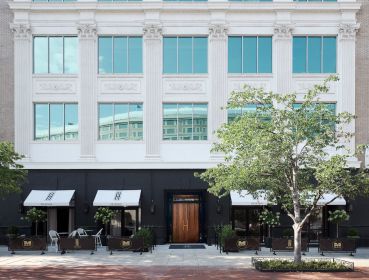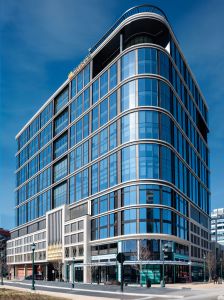Retail Faring Better In Queens’ Residential Neighborhoods Than In Commercial Hubs
By Chava Gourarie September 21, 2020 3:56 pm
reprints
For more than a decade, Sean Cho and Clinton Oh operated a Korean fried chicken joint, Mad for Chicken, in Flushing, Queens. They were one of the first to bring the popular Korean-style dish to New York.
Then, in 2019, the pair opened a second location in Williamsburg, their first foray outside of Queens.
And, since the pandemic shutdowns have lifted, they’ve been in expansion mode.
With the two existing locations doing brisk business in outdoor dining and delivery, Mad for Chicken opened a third location in Bayside, Queens, in July, have a fourth outpost opening in Sunnyside, Brooklyn, this week, and they’re actively looking for other spots.
The Bayside and Sunnyside deals were signed before COVID, but the last few months haven’t slowed Cho and Oh down. “During the pandemic our model has proven to still be successful,” Oh said. “We do have a good takeout and to-go model.”
While Mad for Chicken might be more the exception than the rule, it’s not the only local business spreading its wings, as New Yorkers return to the streets.
In residential neighborhoods in Queens, foot traffic has been robust since the shutdowns lifted, with a combination of local residents, the work-from-home population, and essential workers. And, once outdoor dining resumed in June, restaurant corridors from Flushing to Astoria, to the hard-hit neighborhoods of Jackson Heights, Forest Hills and Corona, have been bustling.
“The outer boroughs from a retail standpoint are better-positioned because of the dense residential population,” Chris Walther, a retail broker with RIPCO Real Estate, said.
That’s particularly true in a borough like Queens, where few residents — many of whom are immigrants — left during the height of the pandemic, said Michael Wang, founder and CEO of Project Queens, a Queens-only commercial brokerage. “The primary reason why the Queens market is more stable is that the demographics are much more sticky,” he said. “There is no other place to go — this is where we live.”
That’s true for most neighborhoods in Queens, but not so for Long Island City, where the tall office towers remain largely empty and the residential population has thinned. “LIC has a similar demographic to Manhattan,” Wang said. “The people from Manhattan moved there so they could commute into Midtown. With a lot of Manhattan offices closed, or still very vacant, that neighborhood shifted, similar to the way Manhattan did.”
While it might change once — and if — offices are up and running full steam, it’s a trend LIC will have to live with in the meantime.
“LIC is going to trade more like Manhattan to an extent,” Walther said. “You have the office component. When that’s vacant, that’s a big driver for daytime population, and that’s not there anymore.”
With the office market frozen, some of the new developments in Long Island City remain largely empty, including the Jacx, a two-building office campus from Tishman Speyer, with over 1.2 million square feet, which was completed in 2019. The anchor tenant, Macy’s, which leased a combined 867,000 square feet in two separate deals in 2017 and 2019, delayed its move to the Queens Plaza site once the pandemic hit. Macy’s plans to occupy all 22 floors of the east tower, called Three Jackson. Its subsidiary Bloomingdale’s completed the buildout of the 11 floors of the neighboring tower, One Jackson, and will fill it once its workforce returns, Tishman Speyer confirmed.
The third major tenant at the property is WeWork, which leased 215,000 square feet at One Jackson, and has occupied the space since January. The retail component, including a food hall will open before the end of the year, per the developer.
Macy’s and WeWork did not respond to requests for confirmation about their move-in or opening dates.
Meanwhile, in Astoria, the neighborhood’s 30th Avenue was so packed in June that the city received dozens of complaints about the lack of social distancing, according to news reports.
That being said, it’s not only commercial-heavier neighborhoods that the coronavirus has gutted in Queens. Many local businesses, especially restaurants with large indoor spaces or ones far from retail corridors, have been decimated as well. In fact, Frank Arcabascio of Astoria’s 30th Avenue Business Association has said that roughly 10 percent of businesses there are currently closed, some permanently, and that he estimates 60 percent will close within six months without assistance.
“There’s no long-term,” Arcabascio, who owns a salon on 30th Avenue, said. That’s because, he added, the rules keep changing, and every time the city or state loosens restrictions, they add new ones. “We understand why, but at the same time we are policing ourselves, otherwise we’ll go out of business.”
Citywide, 83 percent of restaurants and bars did not pay full rent in July, and 37 percent paid no rent at all, according to the NYC Hospitality Alliance.
It’s primarily the daily need uses—bodegas, grocers, delis—and some restaurants that are holding on in Queens, said RIPCO’s Walther.
And, for those businesses, with the market where it’s at, it can be a good time to score deals for rents and in locations they couldn’t have previously, Project Queens’ Wang said.
Closer to Home
Eric Benaim, president of residential brokerage Modern Spaces, said the borough’s housing stock, both in Long Island City and elsewhere, is sought after, though not at the level as pre-COVID. What’s more, the source of the activity has shifted a bit.
“We’re now getting a lot more people from Manhattan,” Benaim said. “We are getting people moving to the suburbs or Florida or wherever, but we’re also getting people moving here from Manhattan.”
For example, in Long Island City, Modern Spaces launched a townhouse rental project several weeks ago, and units are moving quickly, Benaim said. Each of the 38 three-story townhouses includes two units, so every home has outdoor space — either a yard or a rooftop deck — something many New York residents are happy to pay for during a pandemic.
The company has been discounting condo prices in Long Island City between 4 and 10 percent, Benaim said. Overall, in-contract prices for condos were down 21 percent in the second quarter, according to a market report from Modern Spaces, compared with an 8 percent increase in Astoria.
On the rental side, rents were down in Northwestern Queens by roughly 5 percent year over year according to a second-quarter report from brokerage Douglas Elliman, half of Manhattan’s rapid 10 percent decline. While the volume of rental leases was up in both Astoria and Long Island City by about 18 percent from the first to the second quarter, Astoria rents were down 7 percent compared with three 3 in Long Island City, per the Modern Spaces report.
Since Labor Day, Wang said he’s seen a real resurgence in most neighborhoods in the city’s largest borough by area. Parking lots are full, small offices are occupied, malls are opened up, and indoor dining is around the corner. But, he cautioned, not only do we not know what comes next, we don’t know how much damage has been done so far.
“The full effect of COVID is not clear yet,” he said. “[Businesses] are hurting from six months of closure, and how the winter plays out is a huge factor.”
“It’s still day by day, week by week.”
Update: This story has been updated to reflect that WeWork has occupied the Jacx since January, according to information from Tishman Speyer.


